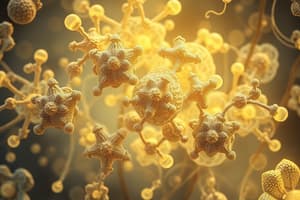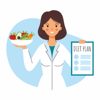Podcast
Questions and Answers
Lipids usually have:
Lipids usually have:
- A fatty acid attached to them (correct)
- A glucose attached to them
- A protein attached to them
- None of the above
Unsaturated fatty acids:
Unsaturated fatty acids:
- Have a double bond somewhere in them
- All of the answers are correct (correct)
- Have a 'kink' in their structure
- Do not pack tightly together
A triglyceride (also known as a triacylglycerol):
A triglyceride (also known as a triacylglycerol):
- Is a non-toxic way to store fatty acids
- Has 3 fatty acids attached
- All of the answers are correct (correct)
- Is known as fat
A phospholipid has:
A phospholipid has:
Cholesterol is:
Cholesterol is:
Soybean oil started to provide a significant amount of calories in the American diet in about:
Soybean oil started to provide a significant amount of calories in the American diet in about:
Canola oil was developed in:
Canola oil was developed in:
During digestion, fat droplets in food are solubilized and made smaller:
During digestion, fat droplets in food are solubilized and made smaller:
The following are enzymes that hydrolyze lipids:
The following are enzymes that hydrolyze lipids:
What is found in a typical Chylomicron or Very Low Density Lipoprotein Particle in blood?
What is found in a typical Chylomicron or Very Low Density Lipoprotein Particle in blood?
The lipoprotein particle that is assembled in the enterocyte and delivers dietary fat throughout the body is called:
The lipoprotein particle that is assembled in the enterocyte and delivers dietary fat throughout the body is called:
Dietary lipids are first transported to the following tissues:
Dietary lipids are first transported to the following tissues:
Way after the meal is over, you are kept alive by the endogenous lipid cycle called:
Way after the meal is over, you are kept alive by the endogenous lipid cycle called:
In the Dixon cycle: In the adipose cells (fat cells), stored triglyceride are hydrolyzed (broken down) by cellular lipases to produce free:
In the Dixon cycle: In the adipose cells (fat cells), stored triglyceride are hydrolyzed (broken down) by cellular lipases to produce free:
In the Dixon cycle: Albumin carries the following around the body:
In the Dixon cycle: Albumin carries the following around the body:
Excess and unused fatty acids carried by albumin are taken up by:
Excess and unused fatty acids carried by albumin are taken up by:
After reforming, triglycerides in the liver are returned through the blood to other tissues, including the heart, in:
After reforming, triglycerides in the liver are returned through the blood to other tissues, including the heart, in:
The two parts of the Dixon Cycle, fatty acids bound to albumin and triglycerides in VLDL, constitute two systems that are fairly redundant and deliver energy (fatty acids) to all tissues 24/7 in order to:
The two parts of the Dixon Cycle, fatty acids bound to albumin and triglycerides in VLDL, constitute two systems that are fairly redundant and deliver energy (fatty acids) to all tissues 24/7 in order to:
When someone has not eaten for 2 or 3 days, the Dixon cycle increases by:
When someone has not eaten for 2 or 3 days, the Dixon cycle increases by:
Having extra fat (adipose triglycerides) may be evolutionary significant because having more fat allows a human:
Having extra fat (adipose triglycerides) may be evolutionary significant because having more fat allows a human:
The heart in most people usually has this number of main coronary arteries:
The heart in most people usually has this number of main coronary arteries:
The coronary arteries can have a complete blockage that causes a heart attack when:
The coronary arteries can have a complete blockage that causes a heart attack when:
Flashcards are hidden until you start studying
Study Notes
Lipids
- Lipids are usually composed of a fatty acid attached to them.
- Unsaturated fatty acids:
- Have a double bond somewhere in their structure
- Do not pack tightly together
- Have a “kink” in their structure
- Triglycerides (or triacylglycerols):
- Are known as fat
- Have 3 fatty acids attached
- Are a non-toxic way to store fatty acids
- A phospholipid:
- Has a phosphate group attached
- Has 2 fatty acids attached
- Is an important component of the membranes of cells
- Cholesterol strengthens the cell membrane.
Dietary Lipids in the American Diet
- Soybean oil started to provide a significant amount of Calories in the American diet in about 1950.
- Canola oil was developed in Canada.
Digestion of Lipids
- During digestion, fat droplets in food are solubilized and made smaller by secretion of bile acids and salts into the small intestine.
- Enzymes that hydrolyze lipids:
- Cholesteryl ester hydrolase
- Pancreatic Lipase
- Phospholipase A2
Lipoprotein Particles
- A typical Chylomicron or Very Low Density Lipoprotein Particle in blood contains:
- ApoB Protein
- Cholesteryl Ester
- Triglycerides
- Phospholipids
- The lipoprotein particle that is assembled in the enterocyte and delivers dietary fat throughout the body is called a Chylomicron.
- Dietary lipids are first transported to the liver, followed by other tissues.
The Dixon Cycle
- The Dixon cycle is the endogenous lipid cycle responsible for keeping you alive after a meal.
- In the adipose cells (fat cells) stored triglyceride are hydrolyzed (broken down) by cellular lipases to produce free fatty acids.
- Albumin carries free fatty acids around the body.
- Excess and unused fatty acids carried by albumin are taken up by the liver, and reassembled into triglycerides.
- After reforming, triglycerides in the liver are returned through the blood to other tissues, including the heart, in VLDL (Very Low Density Lipoprotein).
- The two parts of the Dixon Cycle, fatty acids bound to albumin and triglycerides in VLDL, constitute two systems that are fairly redundant and deliver energy (fatty acids) to all tissues 24/7 in order to keep you alive at all times - even in the middle of the night.
- When someone has not eaten for 2 or 3 days, the Dixon cycle increases by hydrolyzing more adipose triglycerides and releasing them as fatty acids.
- Having extra fat (adipose triglycerides) may be evolutionary significant because having more fat allows a human to survive longer during a severe famine.
Coronary Arteries
- The heart in most people usually has three main coronary arteries.
- The coronary arteries can have a complete blockage that causes a heart attack when the arteries fill up almost completely with foam cells containing cholesterol.
Studying That Suits You
Use AI to generate personalized quizzes and flashcards to suit your learning preferences.





